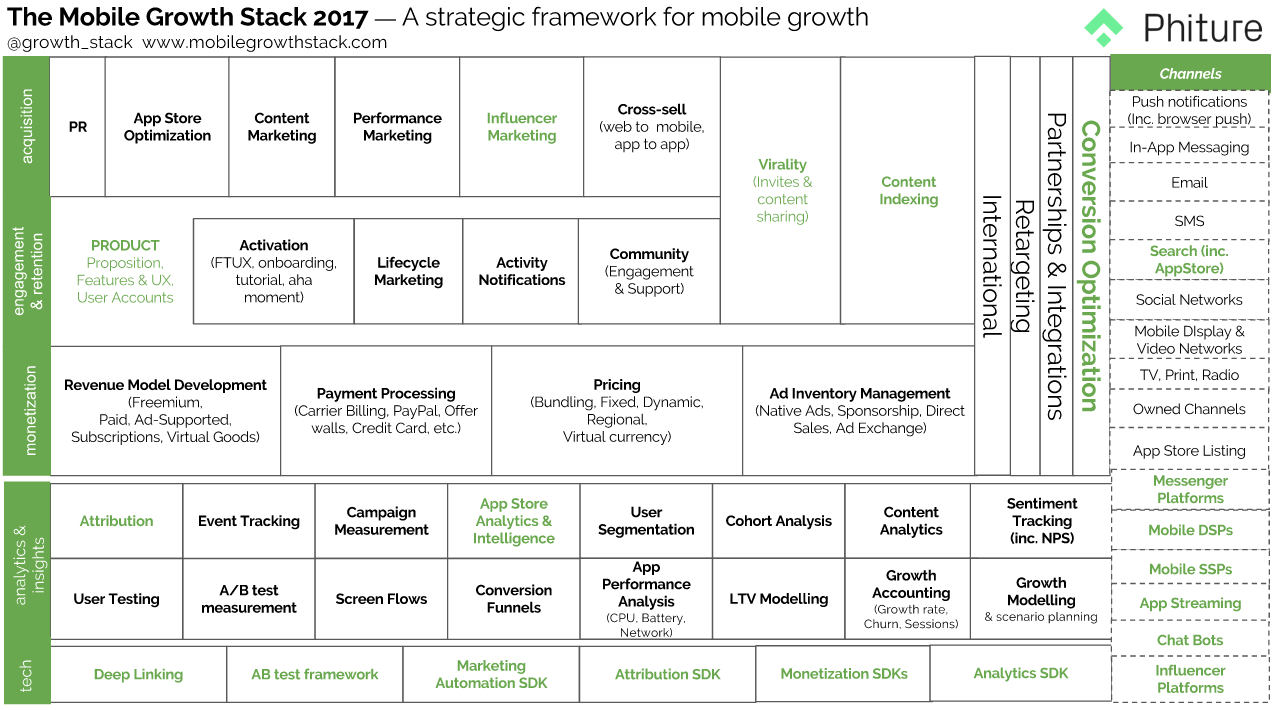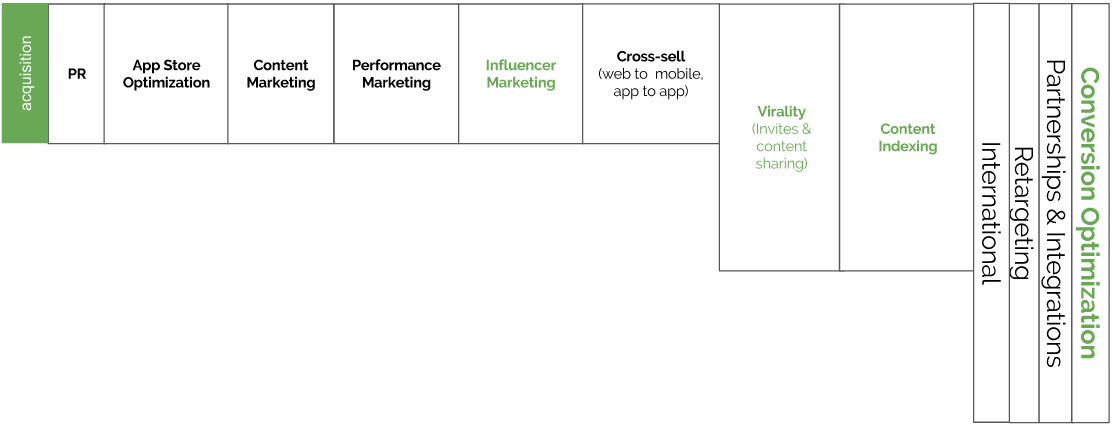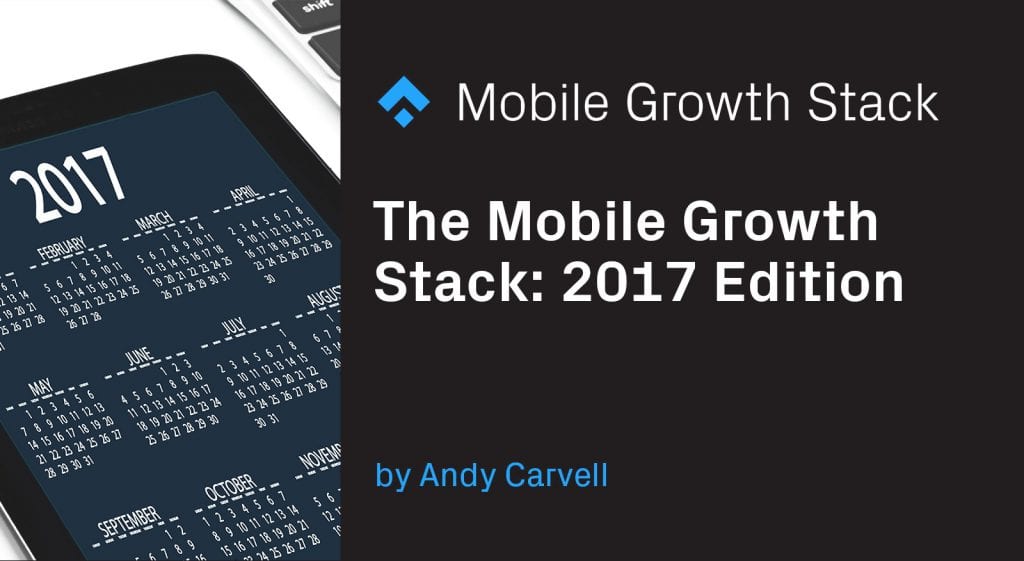
2016 was a busy year for the world of Mobile Growth Marketing. The mobile ecosystem keeps evolving, as does the definition of a ‘mobile product’. Furthermore, growth teams and founders of mobile businesses continue to develop new strategies and tactics and explore new channels in an effort to stay ahead of the curve when it comes to acquiring, retaining and monetizing users.
2016 was also a busy year for Phiture, the mobile growth consultancy that Moritz Daan and I co-founded. We now work with companies all around the world, helping them apply the mobile growth stack and take a strategic approach to growth. At the end of 2016, I had the pleasure to present at Growth Stack SF, a growth conference in San Francisco. I presented a sneak peek to the 2017 Mobile Growth Stack: a revised and updated version of the framework that incorporates the major developments and trends for mobile growth since the previous update was published.
Here is the Mobile Growth Stack 2017:
What Is The Mobile Growth Stack?
For those who aren’t familiar with the Mobile Growth Stack, it’s a sort of ‘mobile cheat sheet’… a one-page chart / diagram that helps growth practitioners think more holistically and strategically. The framework organizes the levers for growth by the key funnel stages (acquisition, engagement & retention and monetization), helping growth practitioners consider everything they could do to drive growth of their mobile product at each stage, which in turn helps define focus areas and build a coherent strategy. For an in-depth guide to every element of the stack, check out this link at MobileGrowthStack.com. For a guide on how to use the framework to develop a holistic mobile growth strategy, check out the Applying the Stack page.
What’s Been Updated For 2017?
This year’s update includes a brand new layer: ‘tech’, which encourages consideration of enabling technology choices. The ‘analytics & insights’ layer has been simplified slightly, with a few of the elements being combined, or removed. The acquisition layer now includes influencer marketing, a newly-added activity. The stack now acknowledges the dual benefits conferred by Virality and Context Indexing, by extending them to cover both the acquisition and engagement & retention layers. The engagement & retention layer now has ‘Product’ at it’s core, to clarify that an engaging product is absolutely core to any kind of longer term retention and a pre-requisite to growth marketing efforts in this layer. Finally, a number of new channels have been added to make this part of the stack more complete and to incorporate new developments.
Changes this year are highlighted in GREEN below:
Influencer Marketing As A New Activity In The Acquisition Layer
The term ‘influencer marketing’, in its broadest sense, covers a broad range of activities that involve working with influential individuals or groups to obtain brand or product advocacy or endorsement from them. This concept is far from new: tobacco companies have been influencing us via movie stars for generations, commercial sponsorship of sporting personalities is taken for granted, and so on.
Working with influencers has traditionally been hard to measure, time-consuming and potentially expensive, but often nonetheless effective. The emergence of performance-centric influencer platforms (such as discovry.io), connecting advertisers with a new generation of independent influencers — bloggers, YouTube stars, Instagrammers, Snapchatters, etc. — has democratized a space once dominated by big brands and celebrity agents. It’s now possible to scale influencer marketing to groups of influencers that individually have a smaller reach — albeit among loyal audiences interested in potentially niche topics — than the superstars with tens of millions of followers. Embeddable tracking links and real-time reporting of impressions and clicks have, at the same time, enabled marketers to be more data-driven with their influencer marketing spend; they can calculate conversion rates, cost-per-install (CPI) and other performance metrics.
Increasingly, influencer marketing is becoming a performance marketing activity that augments or replaces traditional mobile app install campaigns, evaluated against Facebook and DSPs on the same terms. In many cases, these developments have shifted influencer marketing from being a brand marketing activity to a measurable growth tactic.
Virality And Content Indexing For Engagement & Retention
Integrations that enable sharing of app-based content to third party services such as messaging platforms and social networks can be great drivers of viral acquisition. Additionally, as the product grows, and the proportion of the audience exposed to these shares that also has the app installed increases, viral content shares contribute increasingly to app re-entries from existing users. Virality can therefore be considered an important re-engagement lever as the product gains market share.
In exactly the same way, Content Indexing — depending on the precise implementation by Google, Apple or other 3rd parties — offers routes back into the app for existing users in addition to acquisition of new users, in both cases via the discovery of additional content through search. Therefore, Content Indexing has been added to the engagement & retention layer in addition to the acquisition layer.
Conversion Optimization As A New Vertical Layer
Conversion (Rate) Optimization (aka CRO) is an activity that forms the basis of the majority of data-driven growth efforts. In the stack, the term ‘conversion optimization’ is used broadly to refer to efforts to increase rates of conversion between one state to another, as opposed to specifically referring to purchase or subscription events.
So prevalent is the topic of conversion rate optimization that it has been given its own vertical layer of the stack, since this activity can be applied to many activities across the three main layers.
In the acquisition layer, conversion optimization forms an important part of App Store Optimization (optimizing conversion from app store listing impression to install), Performance Marketing (ad impression to click, or click to install), and Cross-Selling efforts between products and platforms.
In engagement & retention, conversion optimization efforts center on moving people between non-engaged or low-engaged to higher states of engagement via numerous means. Conversion optimization is a core activity in lifecycle marketing, where email, push and in-app campaigns are relentlessly optimized for higher open and click rates, as well as improvements in downstream engagement metrics. Product and marketing efforts around activation often aim to convert users from having not performed an activity in the app (e.g. used a feature) to having done so (or done so more often than before), often within a specific conversion measurement window such as the first few days of their lifetime.
In the Monetization layer, optimizing for conversion to a purchase, subscription, incentivized video view, or ad-unit click, are key to increasing profitability and CRO is hence at the core of monetization initiatives.
Product At The Core Of The Engagement & Retention Layer
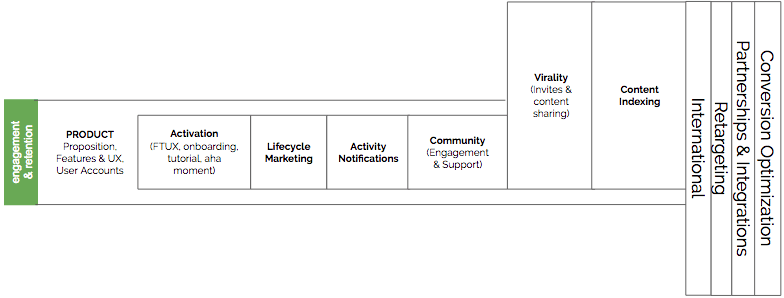
Growth as a discipline sits at the intersection of product (including design), marketing and data science. Earlier versions of the Mobile Growth Stack may have given the impression that engagement and retention are primarily functions of growth marketing; this is manifestly not the case.
Retention stems from an engaging product experience and no amount of activity notifications, lifecycle marketing or community engagement initiatives will keep users using a badly-designed product that they do not find engaging. Product is now explicitly placed at the core of the engagement & retention layer to reflect this.
‘Activation’ Instead Of First Time User Experience
The specific definition of activation is product-specific, and may evolve over time as a deeper understanding of user behavior is gathered and the drivers of longer-term engagement are established more definitively through hypothesis testing. However activation is defined in a specific product, it’s a key growth objective to activate users swiftly in order that they experience the core product value quickly and begin their path to higher and prolonged engagement. This is all a fancy way of saying that users need to find the product engaging early on in order to keep using it. Whilst this, too, is ultimately a function of core product, activation rates will typically benefit from focused effort from both product and marketing sides to assist users on their journey towards their ‘aha moment’.
In the previous version of the stack, this cell was called ‘First Time User Experience’, which seems slightly less all-encompassing than activation, which is a well-understood term in the industry.
New And Expanded Channels:
Search Expanded To Include Paid App Store Search
Search as a channel covers organic and promoted app discovery via search engines and app store searches. This could be via targeting specific keywords, or through indexing in-app content that appears in search results. The channel description in the stack has been updated to reflect paid search opportunities on both Android and iOS platforms and in particular Apple’s Search Ads, which began rollout in 2016.
Messenger Platforms
The meteoric rise in messenger platforms such as Facebook Messenger, WhatsApp, Snapchat, Line, WeChat, etc. has led many to speculate that messaging is the new platform, relegating all other networks and apps to also-rans in the race for smartphone users’ attention.
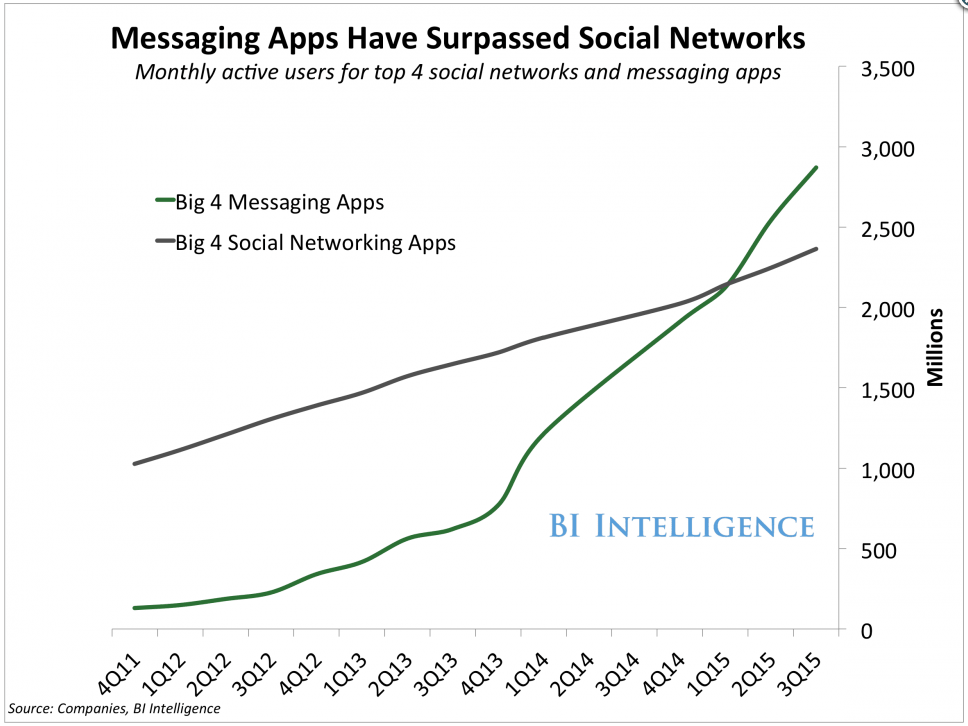
Despite the competitive threat posed by messaging apps themselves to all other apps, they also provide opportunities for apps to reach new and existing users through content sharing, direct messaging (if they provide an API that allows apps to do this) and invites/referrals. Each network is different, with some permitting external links, chatbots and API integrations and others not. In addition to product-level integrations, some platforms (e.g. Snapchat) lend themselves to more traditional marketing activities where awareness and acquisition can be achieved by building an audience through content and/or performance marketing.
Each platform is different; some messaging platforms lean toward group messaging and one-to-many broadcasts while others are predominantly used for person-to-person interactions. Consideration of the dynamics of the chat platform — as well as the messaging habits of the target audience — will help the savvy growth practitioner to prioritize and tailor efforts toward the networks and integrations or marketing efforts most likely to reach and resonate with their ideal users.
Chatbots
Closely related to the topic of messaging platforms is that of chatbots. Chatbots, AI, NLP, digital assistants and conversational interfaces are increasing in prominence and — despite the immaturity of many current experiences — will play an increasingly disruptive role in the way users interact with many platforms and products in many categories.
Chatbots are included in the 2017 Mobile Growth Stack as a channel, although developments over the coming year may modify or clarify this somewhat clumsy classification. The fact is that nobody knows exactly what the future of ‘chatbots’ (itself a vague definition) will bring, or how exactly bots will merge with the current distribution and value chain for mobile products. It’s not too much of a stretch, however, to suggest that chatbots currently present opportunities for integration with — and promotion of — mobile products, as well as presenting another potential touch-point with existing users.
Mobile DSPs And SSPs
The 2017 edition of the stack adds mobile Demand Side Platforms (DSPs) and Supply Side Platforms (SSPs) as channels in their own right, belatedly acknowledging the rise of programmatic advertising. DSPs allow advertisers to buy ad impressions across a range of 3rd party apps or sites, often providing access to multiple ad exchanges, often providing sophisticated targeting criteria and a broad range of options for ad placement. As such, DSPs are an increasingly important part of the performance marketing mix for some companies.
Supply Side Platforms (SSPs) are the publisher-side equivalent: facilitating finer control of monetization via ad inventory inside the product by allowing programmatic buying of ad placement within the app.
App Streaming
Streaming apps and games offer users the chance to experience some or all of the product without ever downloading it as a classic native app from the store. Typically facilitated via HTML5 and with the potential to be distributed over some messaging platforms, app streaming can present a real alternative to traditional distribution and hence is an interesting emergent channel. It remains to be seen to what extent streaming apps will replace traditional app store distribution versus augmenting it, growing overall reach and becoming another touchpoint with the user that coexists alongside native apps. With Google rolling out streaming apps and Facebook ramping up with Instant Games in it’s Messenger platform as well as in the News Feed, app streaming is really coming of age in 2017.
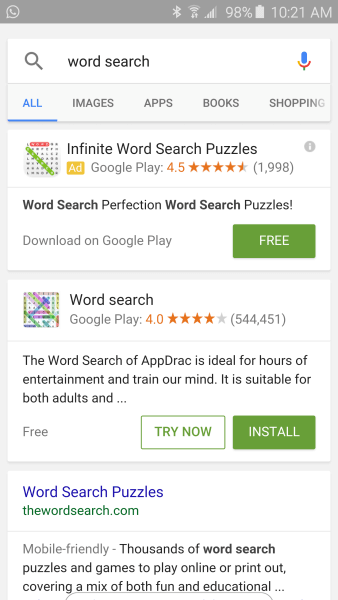
Some apps can now be streamed directly from Google Search results via the “Try Now” button
Enabling Tech Gets Its Own Layer

The aim was, wherever possible, to simplify the stack in 2017, although not at the expense of clarity. While several simplifications were indeed made, they have been canceled out in one fell swoop by the addition of a whole new layer: the tech layer. Deep Linking has been moved here, from the Engagement & Retention layer, since Deep Linking is not an activity or growth driver in and of itself, but is a foundational technology piece that needs to be in place in order to do more interesting and impactful things like content indexing or contextual on-boarding.
There are some key choices to be made when it comes to selecting a vendor for (or possibly even building your own) key enabling technology such as marketing automation, analytics, etc. The tech layer is not attempting to provide an exhaustive list of every category in the vendor space (MParticle’s Periodic Table does a great job of this already), but does aim to cover the most critical and significant tech choices for mobile app growth.
Feedback?
Feedback and suggestions from the community are incredibly valuable in refining the mobile growth stack. If you have thoughts or opinions about this year’s updates to the mobile growth stack, or feel that something has been left out, please leave us a note in the comments section.
Table of Contents


